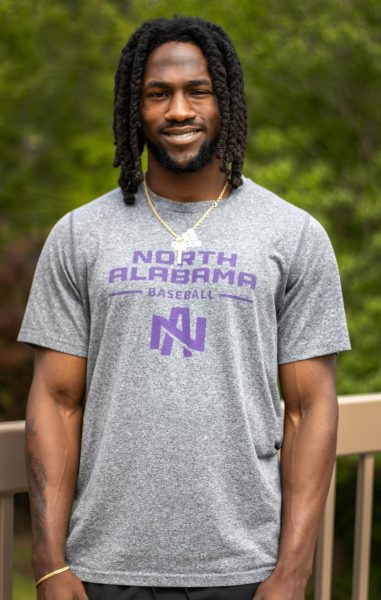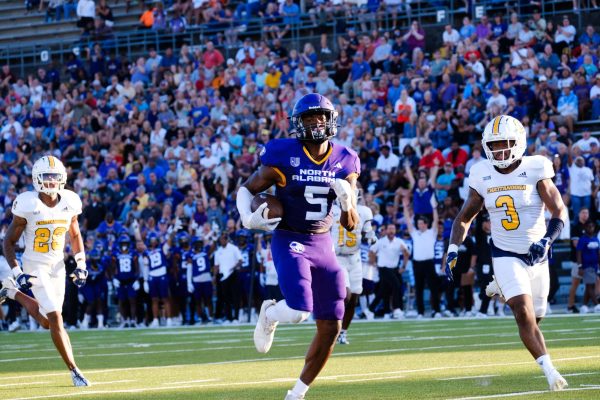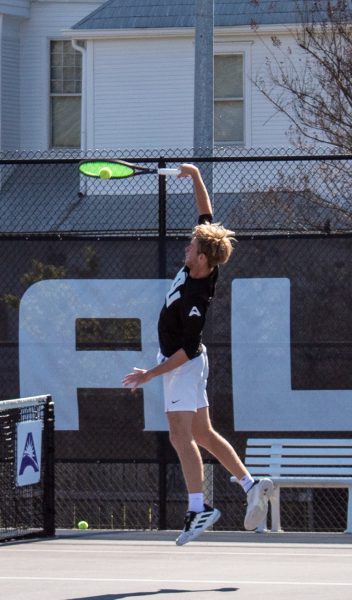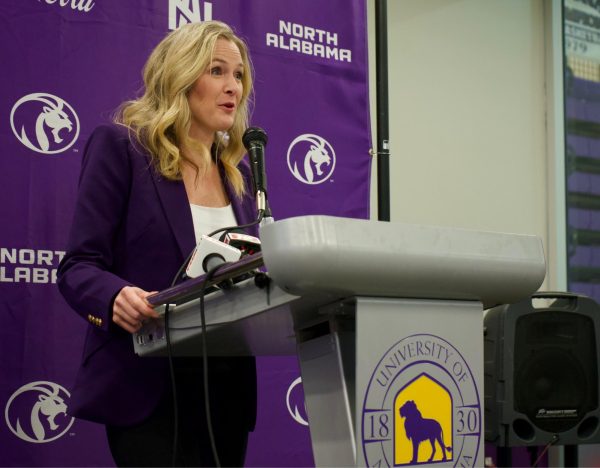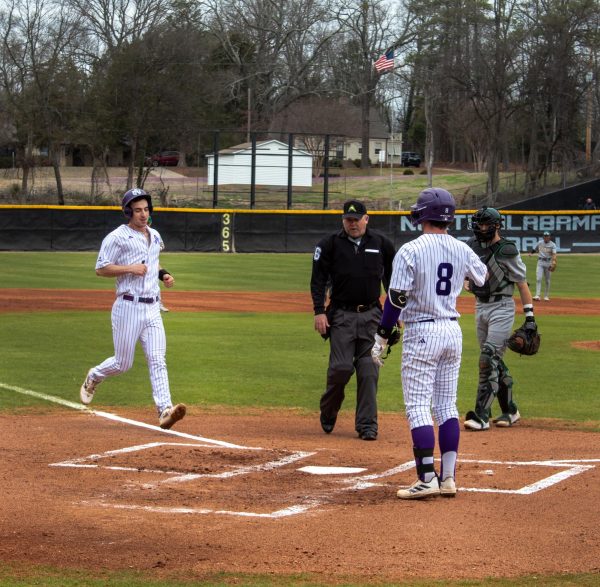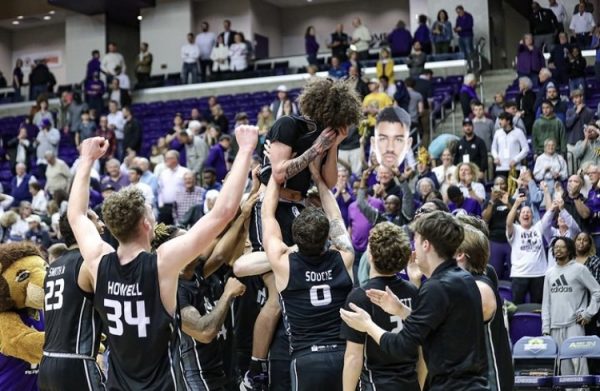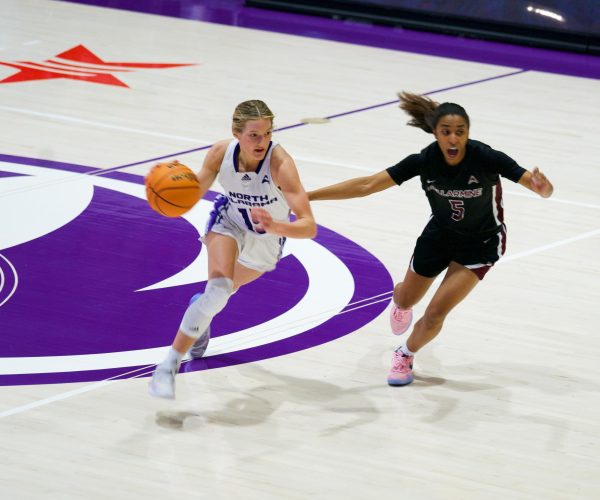Beyond the Bow
February 13, 2020
Its hard to imagine that anyone enjoys waking up to red alarm clock numbers, regardless of the time. Picture the screeching, all too familiar beeps jarring you awake at 4:45 a.m. One of three of the University of North Alabama senior cheer captains, Olivia LeVert, begins her days this way.
Dressed in scrubs, she drives to the hospital for her shift: A 6 a.m. to noon clinical. In a typical day, she’ll swap sterile IVs for sparkly pom-poms.
“Being a nurse is being your patient’s cheerleader,” LeVert said.
For LeVert, this semester includes two days of classes and two days of clinicals, on top of a 36-hour preceptor shift and 60-hour internship.
“Nursing school is the hardest thing I’ve done in my entire life,” LeVert said. “My first [level] was really hard. I almost failed a class. It was really hard going from making all A’s, and I would make, like, an occasional B a semester, to F’s on tests. It was just crazy.”
LeVert started tumbling at age 4, then began cheering on accident two years later. What was supposed to be an afternoon of subbing turned into her lifelong passion.
“You either do cheer or dance,” LeVert said. “I did both.”
Although she referenced a childhood choice, it’s easy to understand how LeVert’s “I did both” attitude grew up into an “I do it all” attitude, in the humblest and most determined of ways.
All the UNA cheerleaders are like this: They manage lives outside of their big smiles, bouncy ponytails, and pictures featured on every university account. They defy the cheerleader stereotype and right now, they’re working to show they’re truly athletes.
“We practice literally in the middle of the night,” said senior captain Sydney Malone. “I feel like it’s the middle of the night, 7 to 9 [p.m.] is really long time for us.”
With any number of games, three practices, and two workouts a week, cheer members squeeze practice in later in the evenings. At this point in the season, the Lions are working towards their first appearance since 2016 at the NCA College National Championship in Daytona Beach, Fla.
“It’s hard having a specific stereotype on your sport,” said senior captain Meredith Daniel. “That’s one thing, having the opportunity to go to Daytona and compete is super important to represent our university and show what we can do. It’s more than just the pom poms.”
This will be the first year the squad travels with coach Megan Dye. After working in the UNA Athletic Department for seven years, Dye took over UNA cheer in 2017.
“We got hit with the injury bug last year,” Dye said. “This has been our first year where we really have the opportunity to go.”
Injuries range from minor bruises to dislocated shoulders, knees and necks due to the elite level of stunting the cheerleaders’ practice. And concussions. Lots of concussions.
“We’ve got one out that’s out on a concussion right now,” Dye said. “She’s going through the concussion protocol to come back.”
Later, at practice, the squad member on concussion protocol, Emma Cotton, a sophomore from Tampa, is sitting right hugging her knees to her chest. She watches the routine eagerly, never seeming bored for an instant.
“When will you get to come back?” I ask her. In front of her, her teammates thrust each other into the air, lock arms and begin to flip forward, then backward.
“Tomorrow,” she answers. Her eyes don’t leave the stunt in progress for a second. One flyer on the right loses her balance. Everyone is reminded of the unforgiving nature of gravity whith the loud sound of falling bodies smacking the blue mat. Cotton explains that she should be in the stunt they keep dropping.
“[We do] a lot of high impact things like the stunting,” Malone said. “We throw girls up in the air that are our body weight and up, so it’s a lot of pressure on your joints too.”
Dye’s voice echoes in my head: “The injuries are real.”
I’m pulled back to the scene in front of me by more falling, and more yelling from the owner of the gym, Paige Kreasy.
“When people think of cheer in Florence,” Dye said. “They think of Paige.”
“[Paige] pushes you but it’s because you can do it and she knows your potential,” LeVert said. “A lot of people don’t see that, but she knows your ability more than you do and if you just believe in yourself you can do the things she says you can do.”
Kreasy has one of the biggest smiles of any woman I’ve seen in my life. She is loud and enthusiastic and inviting, all qualities of a good cheerleader.
“I really love Florence,” Kreasy said. “The schools in this area are doing amazing. And now UNA is really working to do the extra and it is ultimately about our teams, and everybody understands the sports teams come first, but our sport is so much fun and so competitive.”
To graduate from UNA, Kreasy payed for college by working for the National Cheer Association (NCA).
The skills she learned by staffing and directing camps, coupled with her passion for cheer, helped turn her into the queen of cheer in Florence, Ala., 25 years later.
She began teaching at-risk kids in the back of Gold’s Gym. Eventually, interest overwhelmed the space and Cheer Champion Athletics was born. High schools and middle schools in the area practice here, plus they learn tumbling and stunting.
UNA lacks the proper cheer facilities. The cheer team can’t use the practice field if football or soccer uses it, and Flowers gets noisy quickly when cheer upstairs competes with basketball on the court. To eliminate this problem, Kreasy allows the squad to practice here completely for free.
“I’ve always wanted UNA to rise up and be great,” Kreasy said.
With its perfect size, infrastructural improvements and move to Division I, UNA attracts student athletes by offering a chance to shine without sacrificing their entire college experience.
“I think that’s what makes UNA so popular right now,” Dye said. “We’re not just this huge school where you’re gonna get lost. We’re big enough to where you feel like you’re getting the college atmosphere, and we’ve got a cheer program that’s not just so difficult to be a part of.
“You go down to Alabama and Auburn and you’re competing against 400 girls to make a squad. Whereas here, we’ve still got a good respectable squad, but they can come here, and they can be a part of it and not feel so much pressure than at a bigger school.”
This, coupled with the hometown feel of Florence, helps draw the team’s potential members in.
“Meredith?” Dye nodded at her. “She could have gone to Alabama if she wanted to, but this was a better fit for her.”
A freshman from Las Vegas, Kayla Walsh, exemplifies this.
“I went to a Boise State cheer clinic and I just didn’t like it,” Walsh said. “I didn’t feel like I fit in with people there. I told my parents, I was like, ‘I’m gonna go somewhere in Alabama, across the county.’”
Walsh made the squad along with 12 other freshmen. She moved from 600 miles away and for six weeks lived with Malone to participate in summer practices. The dorms didn’t open until August.
“I didn’t even know Sydney,” Walsh said. “I literally DM’d her on Instagram, ‘Can I live with you this summer?’ She was so nice to me and was like, ‘Yeah girl! I’ve got space come on!’ This is my home away from home. It’s with those girls. They know me, my bad sides, good sides, all of it.”
Behind the pictures, pom-poms, and megaphones are strong friends like Malone, fearless leaders like Danie and tail-busting workers like LeVert. The squad is a family mothered by Kreasy and Dye, who inspire not only the girls they coach, but the community as a whole.
“Even though we’re athletes in the Department of Athletics, and dance too, we’re more of the spirit team in their eyes,” LeVert said. “I hope they will see that we do more than come to games and call cheers.”



